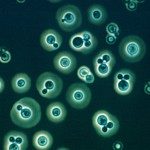Lien vers Pubmed [PMID] – 25351875
BMC Genomics 2014 Oct;15:943
BACKGROUND: The fungal genus Sporothrix includes at least four human pathogenic species. One of these species, S. brasiliensis, is the causal agent of a major ongoing zoonotic outbreak of sporotrichosis in Brazil. Elsewhere, sapronoses are caused by S. schenckii and S. globosa. The major aims on this comparative genomic study are: 1) to explore the presence of virulence factors in S. schenckii and S. brasiliensis; 2) to compare S. brasiliensis, which is cat-transmitted and infects both humans and cats with S. schenckii, mainly a human pathogen; 3) to compare these two species to other human pathogens (Onygenales) with similar thermo-dimorphic behavior and to other plant-associated Sordariomycetes.
RESULTS: The genomes of S. schenckii and S. brasiliensis were pyrosequenced to 17x and 20x coverage comprising a total of 32.3 Mb and 33.2 Mb, respectively. Pair-wise genome alignments revealed that the two species are highly syntenic showing 97.5% average sequence identity. Phylogenomic analysis reveals that both species diverged about 3.8-4.9 MYA suggesting a recent event of speciation. Transposable elements comprise respectively 0.34% and 0.62% of the S. schenckii and S. brasiliensis genomes and expansions of Gypsy-like elements was observed reflecting the accumulation of repetitive elements in the S. brasiliensis genome. Mitochondrial genomic comparisons showed the presence of group-I intron encoding homing endonucleases (HE’s) exclusively in S. brasiliensis. Analysis of protein family expansions and contractions in the Sporothrix lineage revealed expansion of LysM domain-containing proteins, small GTPases, PKS type1 and leucin-rich proteins. In contrast, a lack of polysaccharide lyase genes that are associated with decay of plants was observed when compared to other Sordariomycetes and dimorphic fungal pathogens, suggesting evolutionary adaptations from a plant pathogenic or saprobic to an animal pathogenic life style.
CONCLUSIONS: Comparative genomic data suggest a unique ecological shift in the Sporothrix lineage from plant-association to mammalian parasitism, which contributes to the understanding of how environmental interactions may shape fungal virulence. . Moreover, the striking differences found in comparison with other dimorphic fungi revealed that dimorphism in these close relatives of plant-associated Sordariomycetes is a case of convergent evolution, stressing the importance of this morphogenetic change in fungal pathogenesis.
